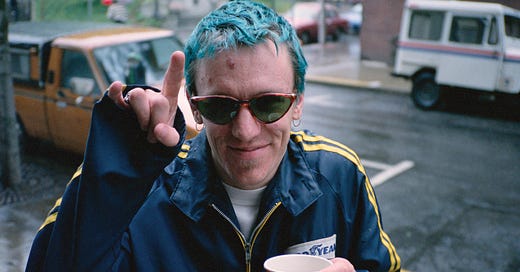I love Elliott Smith, yet I sometimes find myself hiding that fact, fearing the judgement that comes with fan-boying over this whispering misanthrope.
Today, let’s expand ‘folk’ until it falls apart. No, Elliott Smith doesn't sing Child Ballads or Lomax-gathered hollers. He’s a folksinger a la Joni Mitchell — a ‘singer-songwriter’ who utilizes folk stylings. The more common comparison is Nick Drake: both sad balladeers whose lives ended too soon. At his best, Smith writes with Dylan’s poetry, but never with Dylan’s pretension.
A Student of the Sixties
Interviewer: At what age did you realize you wanted to become a musician?
Smith: Probably five as soon as I heard The White Album.
Ignore the greasy bangs, the nineties caricature: Elliott Smith would’ve thrived in the sixties. Although known for his emotionally forthcoming (read: emo) songs, Smith sought to connect his music to a time when art and pop weren’t mutually exclusive. The Kinks, The Who, and Led Zeppelin all make their way onto his list of influences. Like fellow nineties songwriting icon Kurt Cobain, Elliott Smith strove to write songs like the Beatles, hook-driven pop songs.
Smith first garnered attention with his rock group Heatmiser, formed in 1991. The band’s sound was heavier than Smith’s later solo work, but the vocally-foregrounded “Plainclothes Man” hinted at the direction Smith would soon take his music.
Acoustic Pop Perfection
One person, one guitar. For me, the combination is music’s best, the true test of songwriting. It separates coffee house chaff from bar-room bards. I would listen to Smith croon all day — and I have; his Either/Or (inspired by Kierkegaard) is my most listened to album of all time.
“Angeles,” from Either/Or: a ballad to The City of Angeles, sprawling facade, fake friends, painkillers. That haunting ring bookending the song, glowing like hot coals. A train pulling in, tinnitus, San Fernando Valley vertigo. Smith is both the siren and the seduced. Maybe it’s in the multi-tracked vocals — Smith loved to layer take after take until he became a chorus, a crowd. He creates the immediacy of interior monologue. Spotify, Apple Music.
“Somebody That I Used to Know”: no, not the Gotye song (remember when that was top of the charts? Very catchy). By the time Elliott Smith released Figure 8 in 2000, he had mostly moved on to orchestration, Pet Sounds instead of “Blackbird.” But “Somebody” is my favorite style of Smith, him and his guitar. He makes the acoustic new again, like in the intro here, 15 seconds of invention. Smith spent his formative years in Portland, Oregon, and I wonder if he ever encountered a derelict John Fahey. The odd tunings, the musical nods to times past, a penchant for downers, the men had much in common.
To Be Thirteen Again
Fitting that Smith covers Big Star, who also drew heavily from the Beatles. I like this cover for a few reasons. 1) It’s Smith singing an ode to the sixties. 2) It proves Smith can sing sweet and happy. True fans know this to be true (“Say Yes,” “Independence Day”), but Smith gets a bad rap for being nothing more than angsty, emo, goth. It makes me sad; people are missing out. Let’s end on this high note.






